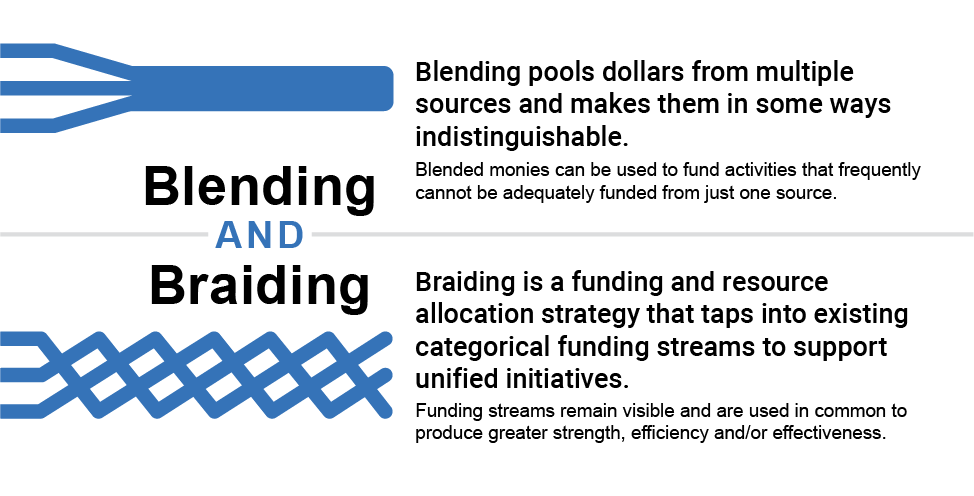INTERAGENCY COORDINATION AND COLLABORATION, INCLUDING EMPLOYMENT FIRST
A variety of state-operated programs and services support individuals with disabilities in their efforts to find and retain employment. Despite sharing similar purposes, programs can become isolated from each other over time. The funding streams supporting them may be associated with different goals, priorities, expectations and requirements, leading to a lack of coordination.
State Policies Relevant to INTERAGENCY COORDINATION AND COLLABORATION, INCLUDING EMPLOYMENT FIRST
Click on the map above to see the corresponding policies.
ALTERNATE VIEW OF State Policies Relevant to INTERAGENCY COORDINATION AND COLLABORATION, INCLUDING EMPLOYMENT FIRST
To achieve job seeker employment goals and respond to employer hiring needs, many states are adopting Employment First initiatives that prioritize establishing competitive integrated employment. In addition, to achieve a consistent outcome, state agencies are developing formal collaboration mechanisms and effective strategies to blend and braid funding and services from these different programs and funding sources to help individuals with disabilities prepare for, secure, and retain competitive integrated employment. Furthermore, many states are using data to measure how well programs achieve employment goals.
Lesson 5 identifies examples of policies relating to interagency coordination and collaboration, including Employment First initiatives that optimize resources and services. To encourage coordination and collaboration between state agencies, policymakers may want to consider a few policy options:
1. Employment First Initiatives
States may want to consider supporting policy alignment, collaboration, coordination and braiding/blending of funding and services across all relevant state systems to facilitate competitive integrated employment for individuals with disabilities, including individuals with the most significant disabilities, through Employment First initiatives adopted through legislation and/or executive orders.
Employment First is a framework that is centered on the premise that all citizens, including individuals with significant disabilities, are capable of full participation in competitive integrated employment and community life. The framework encourages publicly financed systems to align policies, service practices, and reimbursement structures in a way that prioritizes competitive integrated employment.
Individuals have the ability to interact continuously with co-workers without disabilities, have opportunity for advancement and job mobility, and are preferably engaged full-time.
The Office of Disability Employment Policy recognizes that many states desire to support individuals with disabilities using an Employment First approach, but may not yet have the tools, experience or resources to lead and enable such change. In response, ODEP has launched the Employment First State Leadership Mentoring Program (EFSLMP). EFSLMP is providing a platform for state teams to focus on implementing the Employment First approach through the alignment of policies, coordination of resources and updating of service delivery models. Learn More in the Work Matters Framework.
Competitive integrated employment is work that does not differ in pay, benefits, work setting, and advancement opportunities from work done by individuals without disabilities.

Technical assistance documents developed by EFSLMP include:
Medicaid Buy-in Q & A: This document was created collaboratively by the Administration for Community Living (ACL), Centers for Medicare & Medicaid Services (CMS) and the Office of Disability Employment Policy (ODEP) regarding the Medicaid Buy-in, which is an optional Medicaid eligibility group that allows workers with disabilities with income above traditional limits access to essential Medicaid community-based services.
Provider Transformation Manual Guide that supports provider organizations interested in transforming their service delivery models to have an Employment First approach
Provider Transformation Webinar Series 1.0: Webinars for community rehabilitation providers who are interested in transforming their service delivery models to have an Employment First approach
Provider Transformation Webinar Series 2.0: Webinars for community rehabilitation providers who have already begun to transform their service delivery models to have an Employment First approach
Technical Brief #1: Connecting the Dots: Using Federal Policy to Promote Employment First Systems-Change Efforts (PDF)
Technical Brief #2: Federal Legal Framework that Supports Competitive, Integrated Employment Outcomes of Youth and Adults with Significant Disabilities (PDF)
Technical Brief #3: Criteria for Performance Excellence in Employment First State Systems Change & Provider Transformation (PDF)
Technical Brief #4: Federal Resources Available to Support State Employment First Efforts (PDF)
Letter to Governors on Employment First (PDF): On July 22, 2015, then U.S. Secretary of Labor Thomas E. Perez, South Dakota Governor Dennis Daugaard and Delaware Governor Jack Markell signed letters to the Governors of States and U.S. territories urging them to adopt policies and practices that promote the employment of people with significant disabilities in integrated settings earning at or above the minimum wage.
Learn more about Customized Employment, an individualized approach to job development that can assist in advancing integrated employment.
Data and Resources to Inspire a Vision of Employment (DRIVE), funded by ODEP, provides resources for policymakers to learn about national trends and state Employment First systems-change activities.
In addition to the intensive technical assistance and training being offered to the EFSLMP core states, ODEP has launched an Employment First Community of Practice (CoP), which is open to anyone interested in learning more about Employment First. Participants from all 50 states are currently subscribed to the EFSLMP Community of Practice.
2. Cross-Agency Collaboration Under WIOA
The Workforce Innovation and Opportunity Act, or WIOA, requires states to develop and implement a unified or combined state plan. A unified state plan includes the state’s strategic vision and operational planning elements for the core programs (e.g., vocational rehabilitation) included in the comprehensive workforce development system. The combined state plan includes optional educational or social service programs not considered core programs (e.g., the state’s welfare program). This unified or combined state plan acts as a blueprint to facilitate cross-agency collaboration with the goal of increasing employment outcomes for jobseekers, including those with disabilities.
Led by the National Disability Institute, or NDI, the LEAD Center developed materials and resources to assist states and other stakeholders in better understanding the requirements under WIOA as they relate to the unified or combined state plan. These materials and resources can be used to evaluate any state plan and help ensure it is meeting its obligation to include individuals with disabilities and promote cross-agency collaboration. Visit the LEAD Center for more examples of state plans. Learn More in the Work Matters Framework.
3. Formal Public and Private Partnerships
States may want to consider enhancing cooperation and collaboration among state human resources and state agencies that work with people with disabilities by formalizing partnerships (e.g., reviewing and refreshing memoranda of understanding between vocational rehabilitation agencies and education, Medicaid, mental health and intellectual disabilities agencies). Individuals with disabilities frequently receive supports and services through a number of state programs, which often are administered through multiple state agencies and departments. The complexity of navigating these various programs can be cumbersome and can prevent effective service delivery and positive outcomes for jobseekers with disabilities. Ensuring cooperation and collaboration among the various state agencies that provide supports and services for people with disabilities can mitigate these complexities and yield more favorable employment outcomes for individuals with disabilities. Learn more in the Work Matters Framework.
Note: The Workforce Innovation Technical Assistance Center (WINTAC) has developed formal and informal cooperation/collaboration mechanisms, including model memoranda of understanding for use among state agencies.
Suggested Strategies
- Expand and improve links between organizations engaged in increasing employment opportunities for individuals with disabilities. For example, make disability employment part of the state workforce development strategy — ensure physical and programmatic access to American Job Centers, or AJCs, as part of the state plans submitted under WIOA.
- Facilitate collaboration and coordination between federal, state and local educational agencies and state vocational rehabilitation programs, job training, workforce development systems, etc., regarding the design and implementation of career readiness and career development programs, ensuring they are person-centered and disability-inclusive.
- Support existing job coach programs and identify funding sources for expanded job coaching supports for traditional employee placements and entrepreneurial efforts.
- Develop an accessible one-call, one-click system within state governments to offer information and resources to assist and match people with disabilities with appropriate transportation and other services. Methods might include independent living centers, disability resource centers, mobility management systems, state agency councils on coordinated transportation and other “one-stop shop” coordination mechanisms.
